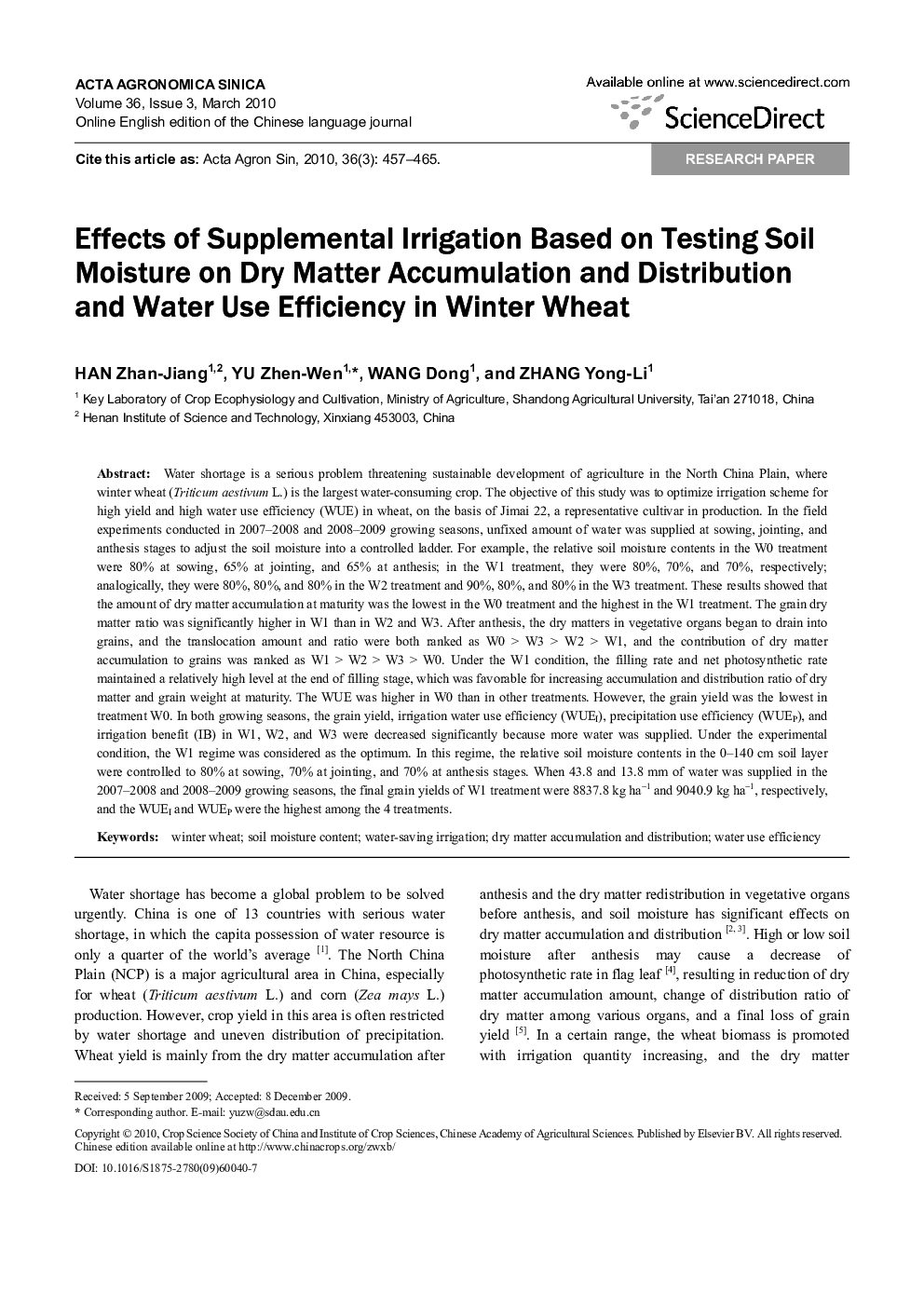| کد مقاله | کد نشریه | سال انتشار | مقاله انگلیسی | نسخه تمام متن |
|---|---|---|---|---|
| 4503272 | 1320884 | 2010 | 9 صفحه PDF | دانلود رایگان |

Water shortage is a serious problem threatening sustainable development of agriculture in the North China Plain, where winter wheat (Triticum aestivum L.) is the largest water-consuming crop. The objective of this study was to optimize irrigation scheme for high yield and high water use efficiency (WUE) in wheat, on the basis of Jimai 22, a representative cultivar in production. In the field experiments conducted in 2007–2008 and 2008–2009 growing seasons, unfixed amount of water was supplied at sowing, jointing, and anthesis stages to adjust the soil moisture into a controlled ladder. For example, the relative soil moisture contents in the W0 treatment were 80% at sowing, 65% at jointing, and 65% at anthesis; in the W1 treatment, they were 80%, 70%, and 70%, respectively; analogically, they were 80%, 80%, and 80% in the W2 treatment and 90%, 80%, and 80% in the W3 treatment. These results showed that the amount of dry matter accumulation at maturity was the lowest in the W0 treatment and the highest in the W1 treatment. The grain dry matter ratio was significantly higher in W1 than in W2 and W3. After anthesis, the dry matters in vegetative organs began to drain into grains, and the translocation amount and ratio were both ranked as W0 > W3 > W2 > W1, and the contribution of dry matter accumulation to grains was ranked as W1 > W2 > W3 > W0. Under the W1 condition, the filling rate and net photosynthetic rate maintained a relatively high level at the end of filling stage, which was favorable for increasing accumulation and distribution ratio of dry matter and grain weight at maturity. The WUE was higher in W0 than in other treatments. However, the grain yield was the lowest in treatment W0. In both growing seasons, the grain yield, irrigation water use efficiency (WUEI), precipitation use efficiency (WUEP), and irrigation benefit (IB) in W1, W2, and W3 were decreased significantly because more water was supplied. Under the experimental condition, the W1 regime was considered as the optimum. In this regime, the relative soil moisture contents in the 0–140 cm soil layer were controlled to 80% at sowing, 70% at jointing, and 70% at anthesis stages. When 43.8 and 13.8 mm of water was supplied in the 2007–2008 and 2008–2009 growing seasons, the final grain yields of W1 treatment were 8837.8 kg ha−1 and 9040.9 kg ha−1, respectively, and the WUEI and WUEP were the highest among the 4 treatments.
摘 要于2007—2008和2008—2009年度小麦生长季, 以高产中筋冬小麦品种济麦22为材料, 在山东兖州小孟镇史王村(35.41°N, 116.41°E)采用大田试验, 研究了4种灌水处理对冬小麦干物质积累与分配及水分利用效率的影响。结果表明, 不灌水的W0处理(土壤相对含水量为播种期80% + 拔节期65% + 开花期65%)成熟期干物质积累量最低, W1处理(土壤相对含水量为播种期80% + 拔节期70% + 开花期70%)成熟期干物质积累量最高, 籽粒干物质分配量显著高于W2处理(土壤相对含水量为播种期80% + 拔节期80% + 开花期80%)和W3处理(土壤相对含水量为播种期90% + 拔节期80% + 开花期80%); 开花前贮藏在营养器官中的干物质开花后向籽粒的再分配量和再分配率均为W0>W3>W2>W1, 开花后干物质积累量对籽粒的贡献率为W1>W2>W3>W0; W1处理在灌浆末期保持较高灌浆速率和净光合速率, 提高了开花后干物质的积累量和向籽粒的分配比例, 有利于增加粒重; W0处理水分利用效率较高, 但产量最低; 灌水处理的籽粒产量、灌溉水利用效率、降水利用效率和灌溉效益两生长季均随测墒补灌量的增加而显著降低。综合两年结果, W1是本试验条件下高产节水的最佳灌溉处理, 其播种期、拔节期和开花期设计0∼140 cm土层土壤平均相对含水量分别为80%、70%和70%, 在两个小麦生长季中, 通过测墒, 分别补充灌水43.8 mm和13.8 mm, 灌溉水和降水的利用效率最高, 并获得了最高籽粒产量, 分别为8 837.8 kg hm−2和9 040.9 kg hm−2。
Journal: Acta Agronomica Sinica - Volume 36, Issue 3, March 2010, Pages 457-465